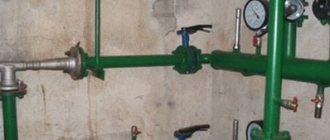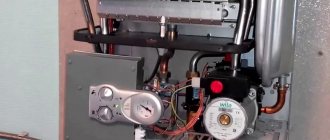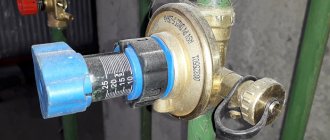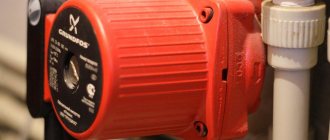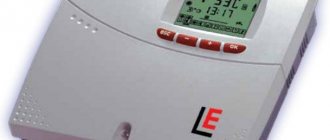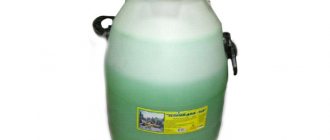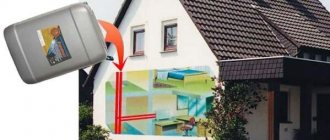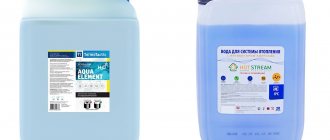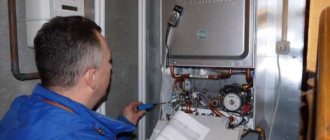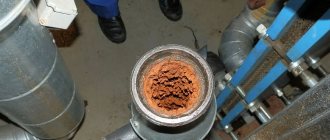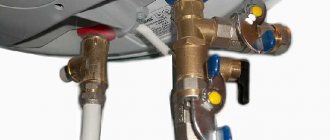When autumn confidently strides across the country, snow is flying above the Arctic Circle, and in the Urals night temperatures stay below 8 degrees, then the word form “heating season” sounds appropriate. People remember past winters and try to understand the normal temperature of the coolant in the heating system.
Prudent owners of individual buildings carefully inspect the valves and nozzles of boilers. By October 1, residents of an apartment building are waiting like Santa Claus for a plumber from the management company. The Lord of valves and valves brings warmth, and with it joy, fun and confidence in the future.
Heating standards for apartment buildings heated centrally
These norms are the most “ancient”.
They were calculated at a time when they did not save on fuel for heating the coolant, the batteries were hot. But houses were built mainly from materials that were “cold” in terms of heat-saving qualities, that is, from concrete panels. Times have changed, but the norms remain the same. According to the current GOST R 52617-2000, the air temperature in residential premises should not be lower than 18°C (for corner rooms - at least 20°C). At the same time, the organization that supplies thermal energy has the right to reduce the air temperature at night (0-5 hours) by no more than 3°C. Heating standards are set separately for different rooms of the apartment: for example, in the bathroom it should be at least 25°C, and in the corridor - at least 16°C.
Society has been fighting for a long time, and at times not unsuccessfully, to change the procedure for determining heating standards, tying them not to the air temperature in the premises, but to the average temperature of the coolant. This indicator is much more objective for consumers, although it is unprofitable for the heat energy supplier. Judge for yourself: the temperature in residential premises often depends not only on the operating system, but on the nature of a person’s life activity and living conditions.
For example, the thermal conductivity of brick is much lower than that of concrete, so in a brick house at the same temperature you will have to spend less thermal energy. In rooms such as the kitchen, the process of cooking food does not generate much less heat than from radiators.
Much also depends on the design features of the heating devices themselves. For example, panel heating systems will have a higher heat transfer rate than cast iron radiators at the same air temperature. Thus, heating standards tied to air temperature are not entirely fair. This method takes into account the outside air temperature below 8°C. If such a value is recorded for three days in a row, the heat generating organization must unconditionally supply heat to consumers.
For the middle zone, the calculated values of the coolant temperature depending on the external air temperature have the following values (for the convenience of using these values using household thermometers, temperature indicators are rounded):
Outside air temperature, °C
Temperature of network water in the supply pipeline, °C
Using the table above, you can easily determine the water temperature in a panel heating system (or any other) by using a regular thermometer at the time of draining part of the coolant from the system. For the forward branch, use the data in columns 5 and 6, and for the return branch, use the data in column 7. Note that the first three columns establish the release temperature of the water, that is, without taking into account losses in the transmission main pipelines.
If the actual coolant temperature does not correspond to the standard temperature, this is the basis for a proportional reduction in the payment for the central heating services provided.
There is also an option to install heat meters, but it only works when all apartments in the building are served by a centralized heating system. In addition, such meters are subject to annual mandatory inspection.
How climate zones affect air temperature
The main factor that is taken into account when calculating the temperature schedule is presented in the form of the calculated temperature in winter. When calculating heating, the outside air temperature is taken from a special table for climatic zones.
The coolant temperature table should be drawn up so that its maximum value satisfies the SNiP temperature in residential premises. For example, we use the following data:
- Radiators are used as heating devices, which supply coolant from bottom to top.
- The type of apartment heating is two-pipe, equipped with parking pipe distribution.
- The calculated values of the outside air temperature are -15 degrees.
In this case we receive the following information:
- Heating will be started when the average daily temperature does not exceed +10 degrees for 3-5 days. The coolant supply will be carried out at a value of 30 degrees, and the return will be equal to 25 degrees.
- When the temperature drops to 0 degrees, the coolant value increases to 57 degrees, and the return flow will be 46 degrees.
- At -15, water will be supplied at a temperature of 95 degrees, and the return will be 70 degrees.
This is interesting! When determining the average daily temperature, information is taken from both daytime thermometer readings and nighttime measurements.
Heating system temperature graph
In this form, the water flow changes, but its temperature remains constant.
Qualitative. The temperature of the liquid changes, but its flow does not change.
In our systems, the second regulation option is used, that is, qualitative.
There is a direct relationship between two temperatures: the coolant and the environment. And the calculation is carried out in such a way as to ensure the heat in the room is 18 degrees and above. Hence, we can say that the temperature graph of the source is a broken curve. The change in its directions depends on temperature differences (coolant and outside air).
The dependency schedule may vary. A specific diagram has a dependency on:
- Technical and economic indicators.
- Climate.
- CHP or boiler room equipment.
High coolant values provide the consumer with great thermal energy.
Below is an example of a diagram, where T1 is the temperature of the coolant, Tnv is the outside air: A diagram of the returned coolant is also used.
Additional influencing factors
The coolant temperatures themselves are also directly influenced by such equally significant factors as:
- A decrease in temperatures outside, which entails a similar decrease indoors;
- Wind speed - the higher it is, the greater the heat loss through the front door and windows;
- The tightness of walls and joints (installation of metal-plastic windows and insulation of facades significantly affects heat retention).
There have been some changes in building codes recently.
For this reason, construction companies often carry out thermal insulation work not only on the facades of apartment buildings, but also in the basements, foundations, roofs, and roofing. Accordingly, the cost of such construction projects increases. It is important to know that insulation costs are quite significant, but on the other hand, this is a guarantee of heat savings and reduced heating costs. For their part, construction companies understand that the costs they incurred for insulating facilities will be fully and soon recouped. This is also beneficial for owners, since utility bills are very high, and if you pay, it is really for the heat received and stored, and not for its loss due to insufficient insulation of the premises.
Minimum temperatures
First, you should pay attention to this point: there is not a single document that would determine the standards for heating batteries. There are documents that regulate the temperature of the coolant and the temperature in the apartment
Why is this so? This can be explained by the different thermal conductivity of the materials used to produce heating batteries, as well as the design features of different models.
Cast iron, steel, copper and aluminum (they are most often used to make radiators) have different thermal conductivities. This means that batteries made from these materials heat up and release heat differently. That is, provided that the coolant temperature at the inlet is 100 °C, the cast iron radiator will not heat up to such a temperature. A copper device can (among the above 4 materials, copper conducts heat the best).
It would be possible to set heating standards for radiators for a specific type of material. However, the situation is complicated by manufacturers who use various tricks when developing radiator shapes. as well as improving the heat transfer of an individual product. Therefore, it is very difficult to develop universal temperature standards for water batteries.
It is also worth adding that batteries with 5 and 11 sections heated to the same temperature create different heat flows. Therefore, the room will warm up differently. Of course, this is said to understand the idea. In practice, when planning a water heating system, the optimal dimensions and required power of the heating battery for each room are always calculated. Therefore, if the entire heating system operates correctly, the battery, which has a sensor and thermostat, will give off the required amount of heat.
From the above it follows that it is best to measure the temperature of the coolant and check whether the resulting indicator corresponds to the norm. This can be done in different ways. Some of them include measuring the temperature of the radiator, and using correction values depending on the material used to make the heating device.
The minimum temperature of the coolant is +30 °C (this is according to the Decree of the State Construction Committee dated September 27, 2003 No. 170). Such water must circulate through a system in which the coolant moves in a “bottom-down” pattern when the outside temperature is +10 °C.
If it is 0 °C outside the window, go to radiators with a sensor. as well as a device for adjusting the heating, water must flow no colder than +57 ° C. It is clear that the battery can heat up almost to this temperature. The above-mentioned document has a whole table that indicates the normal temperature of the coolant at the inlet and outlet depending on the weather and the method of supplying heated water.
Parameters for calculating heating systems: radiators
Heating optimization is related to the thermal output of heating devices.
Radiator batteries have an interval of 140-220 watts. The second parameter for calculation can be found in SNiP; to heat 1 square area, 100 watts are required. This is a rounded value; rooms differ in the degree of insulation.
Types of radiators
Cast iron radiators
Cast iron batteries have proven themselves well. Reliable, have good thermal characteristics. They are inert, take a long time to heat up, but take longer to cool down.
The power of cast iron radiators is calculated by sections; the heat output of one section is 150 watts.
Aluminum radiators
Good heat dissipation up to 200 watts per section, they heat up quickly, but are not durable. They have poor contact with other metals and begin to deteriorate upon contact. Operating temperature - 70 °C
Steel radiators
Good heating, does not have power characteristics like aluminum or cast iron. The power is indicated in the product passport, depending on the size and design: 200W-10kW. Designed to operate at a coolant temperature of 70 °C.
What should the battery temperature be during the heating season?
d) for supply and circulation pipelines of hot water supply networks:
- pressure - based on the highest pressure in the supply pipeline when pumps are operating, taking into account the terrain;
- temperature - in accordance with
SNiP 2.04.01.
Clause 16.9 - Chapter 16 Heating points When calculating the heating surface of water heat exchangers for hot water supply and heating systems, the water temperature in the supply pipeline of the heating network should be taken equal to the temperature at the break point of the water temperature graph or the minimum water temperature if there is no break in the temperature graph, and for heating systems - also the water temperature corresponding to the calculated outside air temperature for heating design. The larger of the obtained heating surface values should be taken as the calculated value.
At the supply it is from 95 to 105 °C, and at the return - 70 °C. Optimal values in an individual heating system H2_2 Autonomous heating helps to avoid many problems that arise with a centralized network, and the optimal temperature of the coolant can be adjusted according to the season. In the case of individual heating, the concept of standards includes the heat transfer of a heating device per unit area of the room where this device is located.
The thermal regime in this situation is ensured by the design features of heating devices
It is important to ensure that the coolant in the network does not cool below 70 °C. 80 °C is considered optimal
With a gas boiler, it is easier to control heating, because manufacturers limit the ability to heat the coolant to 90 °C. Using sensors to regulate the gas supply, the heating of the coolant can be adjusted.
CHP and heating networks: what is the relationship
The purpose of thermal power plants and heating networks is to heat the coolant to a certain value, and then transport it to the place of consumption. It is important to take into account the losses on the heating main, the length of which is usually 10 kilometers. Despite the fact that all water supply pipes are thermally insulated, it is almost impossible to avoid heat losses.
When the coolant moves from a thermal power plant or simply a boiler house to the consumer (apartment building), a certain percentage of water cooling is observed. To ensure the supply of coolant to the consumer at the required standardized value, it is required to be supplied from the boiler room in the maximum heated state. However, it is impossible to increase the temperature above 100 degrees, since it is limited by the boiling point. However, it can be shifted towards increasing the temperature value by increasing the pressure in the heating system.
The pressure in the pipes according to the standard is 7-8 atmospheres, however, when the coolant is supplied, a loss of pressure also occurs. However, despite the pressure loss, a value of 7-8 atmospheres allows for efficient operation of the heating system even in 16-story buildings.
This is interesting! The pressure in the heating system of 7-8 atmospheres is not dangerous for the network itself. All structural elements remain operational in normal mode.
Taking into account the reserve of the upper temperature threshold, its value is 150 degrees. The minimum supply temperature at sub-zero temperatures outside the window is not below 9 degrees. The return temperature is usually 70 degrees.
Temperature measurement techniques
- An ordinary household thermometer on the surface of a heating device.
- A device designed to measure temperature in a non-contact manner. Such a meter is called -.
- Alcohol thermometer.
- A special electrical device.
If you take measurements with an ordinary thermometer, you will need to add a few more degrees to the readings.
The most accurate readings can be obtained using an infrared device - a pyrometer. Its error is no more than 0.5 degrees.
To regularly monitor temperature, use only the safest device - an alcohol thermometer.
For these purposes, it is attached to the radiator using tape and wrapped in thermal insulation material.
How to use the electric version of the thermometer?
You need to take a wire with a thermocouple and attach it to the heating device. This is how the indicators are taken.
If a commission comes to your apartment to measure the temperature of the batteries, they must have a certified device.
You have the right to demand from a representative of the inspecting organization documents confirming that the equipment has passed state verification.
Very serious requirements are placed on the heating system.
The process of delivering hot coolant using circulation pumps (the rules for installation in the heating system are written here) to a residential building and distributing it evenly throughout all apartments is not an easy task.
This issue must be approached responsibly and with an understanding of all technological subtleties.
In order for the heating system to work efficiently, all its elements must function harmoniously.
This applies to all pipes and batteries. in each of the apartments of a multi-storey building.
Therefore, when replacing radiators (read how to install heating radiators in a private house in this article), you need to take into account the features and subtleties of the heating main.
If this is not done, some apartments will experience an excess of heat, while bad times will come for the residents of other apartments (they will have cold radiators).
How can we optimize the heating of urban homes?
Answer: by introducing the following standards:
The safety regulations state that the temperature of the working liquid substance in the heating main must be 20 degrees less than the temperature of self-igniting materials.
For residential multi-apartment buildings, the coolant limit has established standards - 65 - 115 degrees Celsius (this takes into account seasonality);
if the water, for some reason, overheats and reaches the reading of 105 degrees, emergency measures must be taken to prevent it from boiling;
The standard limit for water circulating through batteries is 75 degrees. In case this indicator is exceeded, a restrictive structure must be installed on the battery (about methods of heating distribution in a private house is written here);
in regions located in the middle latitudes of our country, the heating season, as a rule, begins on the fifteenth of October and ends on the fifteenth of April.
In some cases, these standards may be changed.
Service providers should rely on the average daily outdoor temperature.
general information
Here we present the main provisions and excerpts from the current SNiP.
Outdoor temperature
The calculated temperature of the heating period, which is included in the design of heating systems, is no less than the average temperature of the coldest five-day periods over the eight coldest winters of the last 50 years.
This approach allows, on the one hand, to be prepared for severe frosts, which occur only once every few years, and, on the other hand, not to invest excessive funds in the project. On the scale of mass development we are talking about very significant amounts.
Target room temperature
It is worth mentioning right away that the temperature in the room is affected not only by the temperature of the coolant in the heating system.
Several factors operate in parallel:
- Outside air temperature. The lower it is, the greater the heat leakage through walls, windows and roofs.
- Presence or absence of wind. Strong winds increase heat loss in buildings by blowing through unsealed doors and windows into entrances, basements and apartments.
- The degree of insulation of the facade, windows and doors in the room. It is clear that in the case of a hermetically sealed metal-plastic window with a two-chamber double-glazed unit, heat loss will be much lower than with a cracked wooden window and double-strand glazing.
The external façade is covered with basalt fiber slabs.
And, finally, the actual temperature of the heating radiators in the apartment.
So, what are the current temperature standards in rooms for various purposes?
- In the apartment: corner rooms - not lower than 20C, other living rooms - not lower than 18C, bathroom - not lower than 25C. Nuance: when the estimated air temperature is below -31C, higher values are taken for corner and other living rooms, +22 and +20C (source - Decree of the Government of the Russian Federation dated May 23, 2006 “Rules for the provision of utility services to citizens”).
- In kindergarten: 18-23 degrees depending on the purpose of the room for toilets, bedrooms and playrooms; 12 degrees for walking verandas; 30 degrees for indoor swimming pools.
- In educational institutions: from 16C for bedrooms of boarding schools to +21 in classrooms.
- In theaters, clubs, and other entertainment venues: 16-20 degrees for the auditorium and +22C for the stage.
- For libraries (reading rooms and book depositories) the norm is 18 degrees.
- In grocery stores, the normal winter temperature is 12, and in non-food stores - 15 degrees.
- The temperature in the gyms is maintained at 15-18 degrees.
For obvious reasons, there is no need for heat in the gym.
In hospitals, the temperature maintained depends on the purpose of the room. For example, the recommended temperature after otoplasty or childbirth is +22 degrees, in the wards for premature babies it is maintained at +25, and for patients with thyrotoxicosis (excessive secretion of thyroid hormones) - 15C. In surgical wards the norm is +26C.
Temperature chart
What should be the temperature of the water in the heating pipes?
It is determined by four factors:
- Air temperature outside.
- Type of heating system. For a single-pipe system, the maximum water temperature in the heating system according to current standards is 105 degrees, for a two-pipe system - 95. The maximum temperature difference between supply and return is 105/70 and 95/70C, respectively.
- The direction of water supply to the radiators. For upper filling houses (with supply in the attic) and lower filling houses (with a pairwise loop of risers and the location of both lines in the basement), the temperatures differ by 2 - 3 degrees.
- Type of heating appliances in the house. Radiators and gas heating convectors have different heat output; Accordingly, to ensure the same temperature in the room, the heating temperature regime must be different.
The convector is somewhat inferior to the radiator in thermal efficiency.
So, what should be the temperature of the heating - the water in the supply and return pipes - at different outside temperatures?
We present only a small part of the temperature table for the estimated ambient temperature of -40 degrees.
- At zero degrees, the temperature of the supply pipe for radiators with different wiring is 40-45C, the return pipe is 35-38. For convectors 41-49 supply and 36-40 return.
- At -20 for radiators, the supply and return should have a temperature of 67-77/53-55C. For convectors 68-79/55-57.
- At -40C outside, for all heating devices the temperature reaches the maximum permissible: 95/105 depending on the type of heating system in the supply and 70C in the return pipeline.
Temperature of heating radiators in the apartment: standards
Apartment heating standards determine the specific value of a sufficient indicator for residential and non-residential premises, with permissible deviations from their indicators.
They are developed more simply than for work premises, since those living in the housing exhibit low and, at the same time, stable activity:
- For residential premises, the air temperature is from 20 to 22 degrees Celsius, while acceptable limits are considered to be from 18 to 24 degrees;
- If we take corner rooms, then the indicator should not be less than twenty degrees, since such rooms are more susceptible than others to low external temperatures and winds;
What temperature should the apartment be during the heating season?
What to do if the radiators in the apartment are cold, read here.
- The kitchen is a work space where, in most cases, there is a heat source - an electric or gas oven. The temperature in this room should be between 19-21 degrees. Acceptable is from 18 to 26 degrees;
- The optimal temperature for toilets is 19-21 degrees. The limit values range from 18 to 26. One way or another, bathrooms are not among the coolest rooms;
- The bathroom is a hot room because it has a fairly high level of humidity. The minimum temperature here ranges from 18 to 24 degrees. The permissible maximum is 26 degrees. But still, at another 20 degrees, the comfort of using this room decreases;
- For non-residential premises, the temperature is calculated based on the frequency of their operation. In corridors, the acceptable temperature level is 18-20 degrees, however, 16 is also acceptable. For storerooms, the air temperature should be 16-18 degrees. Permissible limits are 12 and 22 degrees.
Since the need for heat during sleep is somewhat reduced, according to GOST, it is allowed to lower the temperature level in residential premises to 3 degrees from 00.00 to 05.00 in the morning. Such a decrease in the norm will not be considered a violation.
What are the requirements for the heating system?
The heating process in a multi-storey building is based on the results of many engineering calculations, sometimes they are not so successful.
The complexity of the process lies not in the delivery of heated water to the facility (building), but in its uniform distribution throughout all apartments, under the conditions of ensuring standard temperature indicators and optimal humidity in the apartments.
How effective such a system will be directly depends on the coherence of all its elements, including pipes and radiators in each apartment.
For this reason, replacing radiator batteries without taking into account the features of the heating system can lead to extremely undesirable consequences: one of the apartments may experience a shortage of heat, while another will have an excess of it.
It is through the establishment of standards that optimization of heating of city apartments is achieved:
- Safety requirements determine that the temperature of the coolant in the heating system should be 20 degrees less than the temperature of materials that tend to spontaneously ignite. For multi-apartment residential buildings, the standard coolant temperature should be in the range from 65 to 115 degrees, taking into account the season;
- When water overheats to 105 degrees, measures must be taken to prevent the liquid from boiling;
- The standard limit for the temperature of water flowing through heating radiators is 75 degrees. If this value is exceeded, the battery must have a restrictive design;
- The heating season in mid-latitudes begins in mid-October and ends in mid-April. In reality, service providers must initiate the start of heating from the moment when an average daily temperature of no higher than 8 degrees is recorded for five consecutive days.
Heat supply of a multi-storey building
Heating distribution unit for an apartment building
Heating distribution in a multi-storey building is important for the operational parameters of the system. However, in addition to this, the characteristics of the heat supply should be taken into account. An important one is the method of supplying hot water - centralized or autonomous
An important one is the method of supplying hot water - centralized or autonomous.
In most cases, a connection is made to the central heating system. This allows you to reduce the current costs in the estimate for heating a multi-storey building. But in practice the level of quality of such services remains extremely low. Therefore, if there is a choice, preference is given to autonomous heating of a multi-storey building.
Autonomous heating of a multi-storey building
autonomous heating of a multi-storey building
In modern multi-storey residential buildings, it is possible to organize an independent heat supply system. It can be of two types - apartment-based or communal. In the first case, the autonomous heating system of a multi-storey building is carried out in each apartment separately. To do this, make independent piping and install a boiler (most often a gas one). A common house installation involves the installation of a boiler room, which has special requirements.
The principle of its organization is no different from a similar scheme for a private country house. However, there are a number of important points to consider:
- Installation of several heating boilers. One or more of them must perform a duplicate function. If one boiler fails, another must replace it;
- Installation of a two-pipe heating system of a multi-storey building, as the most efficient;
- Drawing up a schedule for scheduled repairs and maintenance work. This is especially true for heating heating equipment and safety groups.
Taking into account the peculiarities of the heating scheme of a particular multi-storey building, it is necessary to organize an apartment-by-apartment heat metering system. To do this, energy meters must be installed on each incoming pipe from the central riser. That is why the Leningrad heating system of a multi-storey building is not suitable for reducing operating costs.
Centralized heating of a multi-storey building
Elevator unit diagram
How can the heating distribution in an apartment building change when it is connected to a central heating supply? The main element of this system is the elevator unit, which performs the functions of normalizing coolant parameters to acceptable values.
The total length of the central heating mains is quite large. Therefore, at the heating point, such coolant parameters are created so that heat losses are minimal. To do this, increase the pressure to 20 atm. which leads to an increase in the temperature of hot water to +120°C. However, given the characteristics of the heating system in an apartment building, supplying hot water with such characteristics to consumers is not permitted. To normalize the parameters of the coolant, an elevator unit is installed.
It can be calculated for both a two-pipe and a single-pipe heating system in a multi-storey building. Its main functions are:
- Reducing pressure using an elevator. A special cone valve regulates the volume of coolant flow into the distribution system;
- Reducing the temperature level to +90-85°C. A mixing unit for hot and cooled water is designed for this purpose;
- Filtration of coolant and reduction of oxygen content.
In addition, the elevator unit performs the main balancing of the single-pipe heating system in the house. For this purpose, it is equipped with shut-off and control valves, which automatically or semi-automatically regulate pressure and temperature.
You also need to take into account that the estimate for centralized heating of a multi-story building will differ from autonomous heating. The table shows the comparative characteristics of these systems.
Water temperature in the boiler and heating pipes
After performing the above calculation, it is necessary to adapt the heating temperature table for the boiler and pipes. During heat supply operation, emergency situations should not occur, a common cause of which is a violation of the temperature schedule.
The normal water temperature in central heating radiators can be up to +90°C. This is strictly monitored at the stage of coolant preparation, its transportation and distribution to residential apartments.
The situation with autonomous heat supply is much more complicated. In this case, control depends entirely on the owner of the house
It is important to ensure that there is no excess temperature of the water in the heating pipes that goes beyond the established schedule. This may affect the safety of the system.
If the water temperature in the heating system of a private home exceeds the norm, the following situations may occur:
- Damage to pipelines. This is especially true for polymer lines, where the maximum heating can be +85°C. That is why the normal temperature of heating pipes in an apartment is usually +70°C. Otherwise, deformation of the line may occur and a gust may occur;
- Excessive air heating. If the temperature of the heating radiators in the apartment provokes an increase in the degree of air heating above +27°C, this is outside the normal limits;
- Reduced service life of heating components. This applies to both radiators and pipes. Over time, the maximum water temperature in the heating system will lead to breakdown.
Also, a violation of the water temperature schedule in the autonomous heating system provokes the formation of air jams. This occurs due to the transition of the coolant from liquid to gaseous state. Additionally, this affects the formation of corrosion on the surface of the metal components of the system. That is why it is necessary to accurately calculate what temperature should be in the heat supply batteries, taking into account their material of manufacture.
Most often, a violation of the thermal operating conditions is observed in solid fuel boilers. This is due to the problem of adjusting their power. When a critical temperature level in the heating pipes is reached, it is difficult to quickly reduce the boiler power.
Changes in heating design
Replacement of existing heating devices in an apartment is carried out with the obligatory approval of the management company. Unauthorized changes in the elements of warming radiation can disrupt the thermal and hydraulic balance of the structure.
When the heating season begins, changes in temperature conditions in other apartments and areas will be recorded. A technical inspection of the premises will reveal unauthorized changes in the types of heating devices, their quantity and size. The chain is inevitable: conflict - court - fine.
Therefore, the situation is resolved like this:
- if non-old ones are replaced with new radiators of the same size, then this is done without additional approvals; the only thing you need to contact the management company for is to turn off the riser during repairs;
- if new products differ significantly from those installed during construction, then it is useful to interact with the management company.
Adjustment features
The parameters of heating routes are the responsibility of the management of thermal power plants and heating networks. At the same time, housing office employees are responsible for the network parameters inside the building. Mostly, residents' complaints about the cold concern deviations to the lower side. Much less common are situations where measurements inside thermal units indicate an increased return temperature.
There are several ways to normalize system parameters that you can implement yourself:
- Reaming the nozzle. The problem of lowering the temperature of the liquid in the return can be solved by expanding the elevator nozzle. To do this, you need to close all the gates and valves on the elevator. After this, the module is removed, its nozzle is pulled out and drilled out 0.5-1 mm. After assembling the elevator, it is started to bleed air in the reverse order. It is recommended to replace the paronite seals on the flanges with rubber ones: they are made to the size of the flange from a car inner tube.
- Silence the suction. In extreme cases (during the onset of extremely low frosts), the nozzle can be completely removed. In this case, there is a danger that the suction will begin to act as a jumper: to prevent this, it is turned off. For this, a steel pancake with a thickness of 1 mm is used. This method is emergency, because this can cause a jump in battery temperature to +130 degrees.
- Difference control. A temporary way to solve the problem of temperature rise is to adjust the differential with an elevator valve. To do this, it is necessary to redirect the DHW to the supply pipe: the return pipe is equipped with a pressure gauge. The inlet valve of the return pipeline is completely closed. Next, you need to open the valve little by little, constantly checking your actions with the readings of the pressure gauge.
A simply closed valve can cause the circuit to stop and defrost. A reduction in the difference is achieved due to an increase in return pressure (0.2 atm/day). The temperature in the system must be checked every day: it must correspond to the heating temperature schedule.
The need to perform constructions and calculations
A temperature schedule must be developed for each locality. It allows you to ensure the most competent operation of the heating system, namely:
- Bring heat losses during the supply of hot water to houses into line with the average daily outside air temperature.
- Prevent insufficient heating of rooms.
- Oblige thermal stations to supply consumers with services that meet technological conditions.
Such calculations are necessary both for large heating stations and for boiler houses in small towns. In this case, the result of calculations and constructions will be called a boiler room schedule.
How does a heating regulator work?
A regulator is a device that provides automatic control and adjustment of the temperature parameters of the coolant circulating in the heating system.
It consists of the following nodes and elements:
- Computing and switching unit;
- Actuator on the coolant supply line;
- An actuator for mixing water from the return line (sometimes a three-way valve is used and then they are combined);
- Boost pump on the “cold bypass” line (not always);
- Booster pump on the supply line;
- Shut-off fittings and valves;
- Coolant supply sensor;
- Return sensor;
- Outside air temperature sensor;
- Sensor (sensors in several places) room temperature;
The last two positions can be used either together or instead of each other, depending on how the heating schedule is set.
Now let's figure out how the control processes actually occur, how the regulator works.
Main elements of the temperature control system
The coolant temperature at the outlet of the heating system (return) depends on the volume of water passing through it, since the load is relatively constant. Therefore, the regulator, covering the water supply, increases the difference between the supply and return to the required value (sensors are embedded in these pipelines), to the required value.
If, on the contrary, it is necessary to increase the flow, then a booster pump is installed into the heating system, which is also controlled by the regulator. To lower the temperature of the incoming flow, the so-called “cold bypass” is used - part of the water circulated through the system is again sent to the inlet.
Thus, by redistributing flows depending on the data collected by the sensors, the regulator ensures a strict temperature schedule for the heating system.
One of the Vailant regulator block models
Often the heating controller is combined with a DHW controller using one computing unit. The hot water regulator is much simpler in terms of control and actuators. Using a sensor on the hot water supply line, the passage of coolant through the boiler is adjusted, and the stable 50 degrees required by the standard is ensured.
Determining the optimal temperature for boiler operation and thermal energy transportation
Temperature regulator for one battery
For the most efficient output of boilers, the highest possible temperature is desirable; it is also beneficial when transmitted through a pipeline system, since the same volume of water can transfer more energy, the higher its temperature. Therefore, they try to bring the temperature of the water leaving the boiler closer to the highest permissible limits.
In addition, the minimum heating of the coolant in the boiler cannot be below the dew point (depending on the characteristics of the specific equipment and type of fuel, this is 60-70 degrees), otherwise the boiler begins to “cry” - during combustion, water condenses, which, together with aggressive substances in the flue gases leads to increased wear.
Heating radiator temperature in the apartment: normal
Minimum indicator
It happens that even when the heating is turned on, there is still not enough heat in the apartment. This happens if the standard temperature of the heating radiators in the apartment does not correspond to the real one. As a rule, this happens for several reasons, the most popular of which is airiness in the system. To eliminate it, you can call a specialist or handle it yourself using a Mayevsky crane.
If the culprit is the unsuitability of batteries or pipes, then you cannot do without specialists. In any case, the period when the heating system was not working and the temperature of the radiators in the apartment did not meet the standards according to GOST standards should not be paid by the consumer.
Unfortunately, there is no minimum standard for the temperature of heating radiators in an apartment, so you have to navigate by the air temperature in the room. What heating temperature should be in the apartment? Heating standards for an apartment in an apartment building should vary from +16 to +25 degrees.
In order to document that the temperature of the heating pipes in the apartment does not correspond to the norm, you need to invite a representative of the organization that provides heat to the house.
Why do temperature fluctuations occur?
The reasons for temperature changes are determined by the following factors:
- When weather conditions change, heat loss automatically changes. When cold weather sets in, to ensure an optimal microclimate in apartment buildings it is necessary to expend more thermal energy than during warming. The level of heat loss consumed is calculated by the “delta” value, which is the difference between the street and indoors.
- The constancy of the heat flow from the batteries is ensured by a stable temperature of the coolant. As soon as the temperature decreases, apartment radiators will become increasingly warmer. This phenomenon is facilitated by an increase in the “delta” between the coolant and the air in the room.
The increase in coolant losses must be carried out in parallel with the decrease in air temperature outside the window. The colder it is outside, the higher the temperature of the water in the heating pipes should be. To facilitate the calculation processes, a corresponding table has been adopted.
Heat losses of the building
The initial data in this case will be:
- thickness of external walls;
- thermal conductivity of the material from which the enclosing structures are made (in most cases indicated by the manufacturer, denoted by the letter λ);
- surface area of the outer wall;
- climatic region of construction.
First of all, find the actual resistance of the wall to heat transfer. In a simplified version, it can be found as the quotient of the wall thickness and its thermal conductivity. If the outer structure consists of several layers, find the resistance of each of them separately and add the resulting values.
CHP - a source of hot water for cities
Russia is not called the northernmost country in the world for nothing. Of course, there are states on the planet, parts of whose territories are located at the same latitudes, but only in Russia in the subpolar and polar regions there are thousands of permanently inhabited settlements - we know how to live in conditions that are commonly called “extreme” throughout the world.
But the analytical online journal Geoenergetics.ru will not delve further into political economic issues - let the professionals do this, and we are interested in completely practical consequences from what has been said. Of the 100% of energy generated by the electricity generating capacities of our country, 70% is heat energy, without which our cities would cease to be inhabitable. Consequently, with all the technological perfection of nuclear power plants, which in our time are the highest achievement of world energy, for Russia there is nothing more important than thermal power plants and combined heat and power plants.
The differences between thermal power plants and combined heat and power plants are not just the letter in the abbreviation
A thermal power plant is an energy facility that carries out the joint generation of electricity and thermal energy using burned organic fuel (gas or fuel oil). Heat and electricity from the thermal power plant are supplied to the nearby city. CHP plants are always located in cities, and therefore they burn the cleanest fuel – natural gas. Fuel oil at thermal power plants is used only as an emergency supply of fuel in case of emergency gas shutdown for a short period of time. However, in the history of Russia there were two exceptions to this rule - there was a time when two of our cities provided heat to nuclear reactors that were producing weapons-grade plutonium - we are talking about Seversk and Zheleznogorsk. Therefore, the old jokes on the topic “It’s cold today, throw some uranium into the furnace” had some basis, but after the signing of international agreements to stop the production of plutonium, this exoticism became a thing of the past. If we return to this amazing story, it’s definitely not in this article.
Thermal power plants and thermal power plants are built near cities in the rarest cases - they burn different types of coal, peat, and in some places even fuel oil, which poses too great a risk for the urban ecology. Thermal power plants are usually located near coal mines or near peat mines, which can significantly reduce the cost of delivering huge volumes of burned solid fuel. Due to security reasons, they do not build near large cities and APEC, but this, again, is a completely different story. CHP differs from thermal power plants and nuclear power plants only in that thermal power plants and nuclear power plants generate exclusively electricity and do not supply thermal energy to consumers, completely discharging unnecessary heat through cooling towers or heating the water of the cooling pond, which we have already written about.
Heat dumping is a consequence of a thermodynamic closed cycle, in which getting rid of excess heat is an inevitable process. The efficiency of modern turbines exceeds 40%, that is, more than half of the heat from thermal power plants “flies” into the cooling system and then into the atmosphere unused. We invite you, dear readers, to record this fact: in our country, the coldest country in the world, the heat generated at power plants is discharged into the atmosphere all year round, without bringing any benefit to anyone . Any thermal power plant, regardless of its location, without the slightest harm to its technological processes, is capable, for example, of ensuring year-round operation of greenhouse complexes. Of course, capital costs for such projects will be required in any case, but the presence of heating at zero cost is quite capable of recouping them. But this article is dedicated to thermal power plants, and in cities there are no free areas for such “garden plots”. Moreover, the efficiency of a thermal power plant during the heating season is twice as high as that of thermal power plants, and the reason for this is precisely that the thermal power plant simultaneously produces thermal energy that is useful to our cities.
Dual use increases efficiency
Let us remind you that if natural gas is used as fuel for thermal power plants, the temperature of the steam in front of the turbine reaches 540 degrees Celsius at a pressure of up to 240 atmospheres. High, medium and low pressure cylinders extract from the working steam all the thermal energy accumulated in it - at the exit from the low pressure cylinder (LPC), the steam has a temperature of only 40-50 degrees and a pressure of 5 kPa (kilo pascals) or 5% of atmospheric pressure. The release of energy in the form of smoke emissions from the pipes of boiler furnaces and steam through cooling towers is about 60% of the energy from burned fuel. The further struggle to increase efficiency continues, but supercritical and even ultra-supercritical (in this case, technical terms are used, nothing “literary”) technologies will be discussed in the following articles.
But the efficiency for a thermal power plant can reach as much as 85%, while losses will only be due to exhaust gases in the chimney and to the internal needs of the technological cycle of the thermal power plant itself. The increase in efficiency for thermal power plants is due precisely to the fact that in winter cold it is possible to use the heat from the condensers of a pair of medium-pressure cylinders (MPC) to heat the city surrounding the thermal power plant. Of course, heat from the thermal power plant is supplied to the hot water supply system all year round, but it is required significantly less than for our radiators during the heating season, so the increase in efficiency is associated precisely with heating. In the summer, CHP, like thermal power plants, discharges excess heat to external cooling systems - into cooling ponds, into spray pools and into cooling towers. For simplicity, we will further assume that cooling is carried out only by cooling towers.
CHP plants are often forced to operate under variable conditions, depending not only on the time of year, but also on specific temperatures outside and even on the time of day. No special knowledge is required to understand such variability; it is enough to use common sense.
Five operating modes of thermal power plants
So, when operating a thermal power plant, there are several options for modes of joint simultaneous operation of generators, cooling towers and heating networks:
- During the warm season, CHP plants generate a lot of electricity and dump most of the heat into cooling towers. The cooling tower “smoke” intensely, steaming, the city consumes the minimum heat required for hot water supply. At the same time, the fuel efficiency of thermal power plants is slightly higher than that of thermal power plants;
- In the nominal operating mode of the CHP plant at temperatures down to minus 5 degrees Celsius during the heating period, a certain amount of electricity is generated (less than the maximum power), and all the heat is transferred to the city’s heating network. The cooling tower is idle and there is no steam above it, while the efficiency of fuel use reaches a maximum of 85%. Heat removal is carried out during condensation of steam with a temperature of up to +105C on the LPC, while the third stage - LPC, low pressure cylinder - is idle and does not contribute to the generation of electricity;
- In the transitional mode in the off-season, electricity is generated at an average level, and the heat is discharged partly into the city's heating network and partly into cooling towers. The cooling towers “smoke” at half capacity or one of the two or three available ones is used. At the same time, the fuel efficiency of thermal power plants is higher than that of thermal power plants;
- Electricity is generated insignificantly, but the city's demand for thermal energy is high, which happens on frosty nights on weekends. In this mode, the cooling towers do not “smoke” at all, and the lack of heat is compensated by special peak boiler houses, which do not generate steam, but operate in hot water boiler mode, sending the generated heat past the turbines directly into the city’s heating network. At the same time, the efficiency of electricity generation is maximum (there is no heat discharge into cooling towers), but most of the thermal power plant operates like a conventional hot water boiler house;
- Electricity is generated at maximum, but the city's need for thermal energy is high, which happens on a frosty working day. In this mode, the cooling towers “smoke” heavily, and the lack of heat in the heating network is compensated by peak boilers-heat generators, which do not generate steam, but operate in the mode of a hot water boiler, sending heat past the turbines directly into the city’s heating network. This is the maximum operating mode of a thermal power plant, but the fuel efficiency in this mode is the same as that of a thermal power plant.
The modes of electricity and heat consumption in our cities are often very variable both by year and by day of the week and by time of day, so all five operating modes of thermal power plants smoothly flow into one another in an arbitrary order, depending on the current situation. Based on this, one of the design features of a thermal power plant is its design ability to respond very quickly to load changes, or, as power engineers say, high maneuverability.
Thermal labyrinths of city dungeons
The climatic distribution of temperature during the heating period for central Russia (with the exception of cities on the shores of the Baltic Sea, that is, the Leningrad and Kaliningrad regions) is such that the longest periods of operation of thermal power plants in winter are modes with a slight minus or during thaws, that is, modes 2 and 3. For the sake of these long-term and most economical modes, thermal power plants were created, but the system of hot water supply and heating of buildings and premises is not limited to them. No matter how hard engineers and utility workers try to ensure thermal insulation of the pipes through which it flows into our homes, the climate takes its toll - the water on the way from the thermal power plant to the radiators on the walls of our apartments manages to cool below standard temperature values. And in purely everyday terms, it’s easier to transfer water from a thermal power plant to a residential neighborhood through large-diameter main pipes, so that in some central place for the block (region) it can be distributed through thinner pipes, which bring hot water to our apartments.
Omsk CHPP-3
For main pipelines, the duration of which reaches 10 km or more, steel pipes with a diameter of up to 1,400 mm are used, and central heating stations are located so that the distance to the houses they heat does not exceed 500 meters; pipes with a diameter of up to 150 mm are quite sufficient here; not only are they used steel, but also polymer pipelines. I can talk for a long time about the heat supply systems of large cities - they are developed in such a way as to repeatedly insure against any accidents or emergencies with main hot water pipelines, against possible accidents at the thermal power plants themselves. If there are several thermal power plants in a city, loops are formed on the main water pipelines, which allows, in the event of an accident at a thermal power plant in one district, to distribute the load on the thermal power plants of one or several other districts.
Central heating points
Energy engineers are not chemists with their love of Latin terminology, so the name for such points was given ingenuously - central heating point, central heating point. The central heating point always serves several buildings, and if only one building is served, then the name changes to ITP - Individual Thermal Point.
The equipment of the central heating station allows us to select for each individual house it serves special temperature and hydraulic regimes that correspond to the characteristics of their heating systems, and also protect us from contact with “prepared coolant water” from pipes from the thermal power plant. This is the same water that is prepared for use in the bowels of thermal power plants based on technical requirements - it has standardized indicators of carbonate hardness, oxygen and iron content, pH, as well as a lot of additional reagents that prevent corrosion of pipes and equipment. If city authorities want to avoid constant stress on the part of their residents due to the quality of hot water, they have to use independent central heating connection schemes. In this case, the superheated water coming from the thermal power plant through the primary circuit of the central heating station heats the water passing through an independent secondary circuit, which subsequently enters the hot water supply system and goes to consumers.
Nowadays, the most common heating points operate with a closed hot water supply system (DHW) and an independent connection circuit for the heating system. Now this will have to be “deciphered”.
A closed DHW scheme is when process water in pipes from a thermal power plant and water in the DHW system never mix. The separation of drinking water in the hot water supply system and process water from the heating network occurs on water heating separation heat exchangers. Now the heat exchanger is made in the form of a package of plates, and therefore is called “Plate heat exchangers”. Previously, much more bulky and complex shell-and-tube heat exchangers were used. An independent heating connection scheme is the case when the coolant, that is, hot water from the main network, does not flow directly to consumers into heating radiators, but is divided on a separation heat exchanger, as in the case of DHW heating. In this case, the central heating station is the primary distributor, which divides the total flow of hot coolant into various consumers: heat exchangers of the water heating system for hot water supply and heat exchangers of apartment heating systems.
When separation heat exchangers are installed in central heating centers for both domestic hot water supply and heating systems of individual buildings, this set of heat exchangers for each individual building allows them to withstand individual hydraulic conditions in the systems, in accordance with various design solutions of houses. After all, houses in the same block are not built at the same time and according to the designs of different development companies.
An independent scheme for connecting consumers to heating networks in central heating stations is a wonderful scheme, economically beneficial for thermal power plants - permanent staff for such central heating stations is not required at all, automatic systems allow you to remotely control equipment, regulate the temperature and water pressure in different circuits of different houses. Operating costs are reduced to the cost of electricity required to operate the pumps. By the way, there are always a lot of pumps in the central heating station: in addition to the main ones, there are always backup ones, and the supply of electrical power for them is independent, in order to insure in case of accidents and emergencies in the power supply system.
There are also dependent schemes for connecting heating systems to the heating network. In this case, there is no separation heat exchanger in the central heating station, and water from the heating network enters directly into the apartment batteries through a mixing unit (elevator unit). The dependent connection scheme was widely used in the initial period of construction of mass housing ("Stalinka" and "Khrushchevka") of small number of floors, where a gravity single-pipe heating system was used without the use of additional circulation pumps.
There is only one drawback to dependent central heating stations - if you live in a modern high-rise building, then the coolant from the heating network simply will not reach the radiators on the upper floors due to lack of pressure in the heating network. For new areas with large high-rise buildings, only central heating stations with an independent circuit are used connecting all systems. Finally, it is worth mentioning a very ancient and extremely unpleasant heating supply scheme for people, when for the needs of hot water supply they took hot and dirty water from heating pipes, and cold water came through a separate third pipe. This scheme is called “three-pipe”. It was in memory of the “three-pipe system” that the habit of pouring water into a kettle for boiling only from a cold water tap became established among the people. In modern independent connection schemes, the water in both taps flows of the same drinking quality. So, to get the kettle boiling as quickly as possible, you can safely pour water into it from a “hot” tap.
The three-pipe system remained only in small village boiler houses, which have been standing without reconstruction since the times of the USSR; now, during reconstruction, such boiler houses are being transferred to modern heat supply schemes with closed hot water systems.
Modern central heating stations can be called by analogy “five-pipe”, since five pipes go from the central heating station to the consumer: two for heating radiators, one for cold water, one for hot water, and one pipe for circulation of hot water.
DHW circulation is necessary to ensure that water does not stagnate in the hot DHW pipe and does not cool down when there is no water supply to it. The DHW circulation pipeline returns hot water back to the central heating station for reheating in the DHW heat exchanger.
Central heating point
From an architectural point of view, central heating centers are nothing interesting - concrete boxes in the courtyards of houses with blank walls, gates so that equipment can be changed if necessary, and a door for service personnel. But inside, not everything is so simple - from the previous text this is probably already clear.
External simplicity is sometimes deceiving
Somewhere below, underground, a main pipe with hot water coming from the thermal power plant enters the central heating station - through an inlet called a thermal inlet (what a surprise!). Hot water from the thermal power plant inside the central heating station is distributed into two heat exchangers, for the heating system and for the hot water supply system. The water in the heating circuit, having received its portion of heat, goes into the radiators of our apartments, where it cools down and returns to warm up in the central heating center. The heating circuit is closed, no difficulties. Water from the thermal power plant, having lost its temperature on this heat exchanger, is sent on its way back through the same thermal input (they could call it input-output, they just don’t complicate it). Heat exchanger No. 2 is used to heat the DHW system: tap water comes to the central heating station through the water supply inlet (another surprise), the cold water supply pump sends one part of it to the pipes leading to the cold water taps in the apartments, and the second part to heat exchanger No. 2, for heating from water coming from the thermal power plant. Purely out of delicacy, there are no lines on the diagram depicting a sewer drain, but one can guess its existence without any clues. Water coming from the thermal power plant, having lost its temperature in heat exchanger No. 2, is sent back through the same thermal input. In the presented diagram, everything is quite obvious; some details are omitted from the description.
Scheme of operation of the central heating station
By the way, the diagram clearly shows that the chemical composition of water flowing from a cold tap is no different from the chemical composition of hot water. This diagram is good because it very clearly shows the heated towel rails that are located in the bathrooms. In the heated towel rail in the bathroom, hot water flows all year round with a temperature of the same 60 degrees Celsius. It is for this reason that the heated towel rail is the only always hot heating device in our apartments. The purpose of installing heated towel rails is to continuously pump water (circulation) through the hot water pipes so that the water there does not cool down when water consumption stagnates. If this is not done, then when trying to wait for “hot water” from the tap, you would have to regularly pour large quantities of clean water into the sewer without any useful use. The water temperature in the hot water system of 60 degrees Celsius is determined by a person’s pain threshold, that is, at this temperature a person’s hand does not hurt and burns do not occur.
It remains to be noted that the temperature of the water leaving the central heating station on its way back to the thermal power plant, after it is used to heat the circuits of the heating system and the hot water supply system, is reduced to 50-70 degrees. It’s hard to call it cold; water at this temperature can be used for some useful work. Work that is useful not only for the economy of the thermal power plant, but also for you and me, city residents. Is this option possible - after all, it seems like everything was invented before us? Perhaps the Analytical online journal Geoenergetics.ru will definitely talk about this.
Co-authored with Boris Martsinkevich
Photo: mosenergo.ru
Final conclusions
There are two of them:
- If the hot water temperature is low or excessively high, do not hesitate to invite housing workers to draw up a report on violation of the procedure for providing utility services. Based on it, you can recalculate for hot water supply and pay less than your neighbors;
Commission inspection report on a complaint about low water temperature
- When independently replacing risers and connections for centralized heating and hot water supply, use only metal pipes - galvanized steel, copper or corrugated stainless steel. Modern polymer materials do not have sufficient heat resistance to withstand any prolonged overheating under force majeure circumstances.
Stainless steel pipes for apartment water supply
Coolant temperature depending on outside temperature
Usually a lattice fence is installed that does not impede air circulation. Cast iron, aluminum and bimetallic devices are common. Consumer choice: cast iron or aluminum The aesthetics of cast iron radiators is the talk of the town. They require periodic painting, since the rules require that the working surface of the heating device have a smooth surface and allow dust and dirt to be easily removed. A dirty coating forms on the rough inner surface of the sections, which reduces the heat transfer of the device. But the technical parameters of cast iron products are excellent:
- are slightly susceptible to water corrosion and can be used for more than 45 years;
- have high thermal power per section, therefore they are compact;
- are inert in heat transfer, so they smooth out temperature changes in the room well.
Another type of radiator is made of aluminum.
How to file a complaint?
To begin with, you can limit yourself to calling the housing office: the dispatcher will record the application and find out the reasons - perhaps the violations are caused by breakdowns on the highway or scheduled work.
If the supply of hot water is disrupted without objective reasons, the Management Company is obliged to send an expert to the applicant who will take measurements and draw up an appropriate report.
Important! Resolution No. 354 states that housing and communal services must respond to a complaint no later than two hours from the moment of application.
Management companies are not always ready to admit their guilt. You can often hear the opinion that the management company is not at all obligated to solve problems of this kind. However, it is not. Most often, the heating supply organization is responsible only for the delivery of water to the point of the house system, and then responsibility for the quality of water falls on the management company.
If the administration of the housing office or HOA (homeowners' association) refuses to solve the problem, you need to contact the Housing Inspectorate or directly to the Prosecutor's Office. To confirm your claim to the quality of public services, you will have to conduct an independent examination. You can demand that the management company reimburse its cost, however, if the expert does not identify any shortcomings, the consumer will have to pay for his work.
Recalculation of payment for hot water supply
So, if hot water does not meet SanPiN or SNiP standards, payment for hot water consumption can be recalculated. Full requirements for the quality of utility services and recalculation rules are set out in Resolution No. 354.
Important! If the water has a temperature below 40 degrees Celsius, it must be paid at the cold rate.
According to Art. 154 of the Housing Code of the Russian Federation, the consumer pays for hot and cold water, energy spent on heating water, and water disposal (sewage). The total payment is calculated based on the readings of individual meters or communal meters. If neither one nor the other is available, then payments are accrued according to the standards.
In the receipt you can find the “recalculation” column, which adjusts the payment amount if there are grounds for this. The difference between the paid and the actual amount is transferred to future utility payments.
Payment adjustments downward are made based on the consumer’s application and the protocol report on identified violations.
In the application for recalculation you must indicate:
- in the “header” - the name of the service organization and information about the resident: full name, address;
- indicate in the text the reasons on the basis of which the recalculation should be made: lack of water, poor quality of the service provided;
- list the attachments to the claim: acts, protocols, if any;
- put the date and signature.
Payment for hot and cold water can also be reduced if the tenant has been absent for more than five days. However, this is possible if payment is calculated according to standards, without meters, and requires documentary evidence (transport tickets, a certificate from the hospital, etc.).
Recalculation is made within five working days, and if the Management Company does not agree with the claim, then the tenant must receive a written reasoned refusal no less than a month from the date of application.
